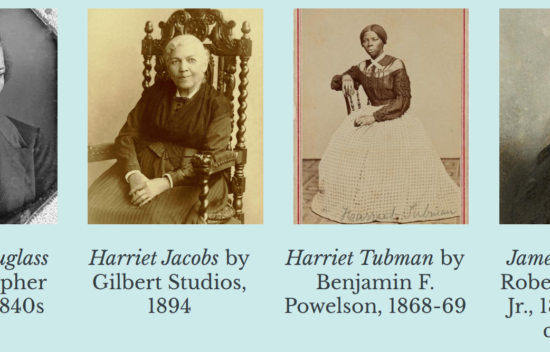Fifteenth Amendment Art Teacher Resource
This document contains a guide for the The Fifteenth Amendment artwork by Thomas Kelly. Use this guide to point out interesting attributes and guide your students through viewing this detailed artwork. Teacher note: The activity has been numbered to guide student understanding and build connections. Be aware that the numbers in this activity do not match the numbers on the primary source.
Art Investigation Context Guide
- “Center- “Celebration of Fifteenth Amendment, May 19th, 1870” (at center) Large vignette of Black parade with drums and horse-mounted men leading marchers on foot, viewed by a friendly white audience.
- 1. President in 1870, Ulysses S. Grant. After his success as a general during the Civil War, Grant easily won the presidential election in 1868 and again in 1872. Grant was a vocal supporter of the Fifteenth Amendment’s extension of voting rights to African Americans as a way for moving the nation forward.
- 2. African American leaders Martin Delany, Frederick Douglass, and Hiram Revels. Martin Delany was co-editor of the abolitionist newspaper The North Star. He also practiced medicine and rose to the rank of major during the Civil War. Frederick Douglass was co-editor of The North Star newspaper as well. He also was an active speaker and civil rights advocate, including meetings with President Lincoln in the White House. Hiram Revels was a leader who worked to improve education for Blacks and would eventually be the first African American elected to the U.S. Senate.
- 3. Vice President in 1870, Schuyler Colfax. As speaker of the House during the passage of the Thirteenth and Fourteenth Amendments, Colfax had made his abolitionist views and support for African American rights clear. Colfax was a popular choice for vice president as he would be able to lead the Senate during Reconstruction.
- 4. “Life, Liberty, and Independence” Sword and olive wreath- Featured in text are the inalienable rights of life, liberty, and the pursuit of happiness from the Declaration of Independence now guaranteed to African Americans through the passage of the Thirteenth, Fourteenth, and Fifteenth Amendments. The sword represents the fight for these rights, and the olive branch wreath represents the peace that should now accompany new beginnings.
- 5. “The Right of Citizens of the U.S. to vote shall not be denied or abridged by the U.S. or any State on account of Race, Color, or [previous] Condition of Servitude – Fifteenth Amendment” Quill pen and a scroll of the Constitution of the United States featuring the text of the Fifteenth Amendment. The amendment also states that Congress has the power to enforce the right of Blacks to vote, which they will later need to do through various acts and legislation.
- 6. “Reading Emancipation Proclamation” A Black man is holding a document titled PROCLAMATION at the top and LINCOLN at the bottom, signaling he is reading the Emancipation Proclamation. The Emancipation Proclamation freed enslaved people in Confederate states before the Thirteenth Amendment officially ended slavery in the entire country after the war.
- 7. “We till our own Fields” Two Black men harvesting grain. Enslaved Blacks could not own their own land or keep the fruits of their labor.
- 8. “We Unite the Bonds of Fellowship With the Whole Human Race” Three men dressed in sashes and aprons of Black fraternities, which are like clubs. Enslaved Blacks were denied their humanity, and Reconstruction was an attempt to integrate freed Blacks into society on equal footing.
- 9. “We will protect our Country as it defends our Rights” Black military unit parading past cheering white spectators. Thousands of Black men proudly fought in the Civil War for the Union.
- 10. “Our charter of Rights – The Holy Scriptures” Book labelled “Holy Bible”. Some of the most prominent anti-slavery arguments had a foundation in the Bible and its teachings of love and equal treatment for all.
- 11. “Freedom unites the Family Circle” A scene of a Black family in their home. Enslaved Blacks were not able to enjoy family bonds like free people. Families were frequently torn apart when parents, siblings, and children were sold to separate owners.
- 12 and 13. Deceased white advocates of Black rights, Abraham Lincoln and John Brown. Lincoln led the Union during the Civil War and authored the Emancipation Proclamation. John Brown was an abolitionist who attempted to incite a slave rebellion in the South on the eve of the Civil War.
- 14. “Education will prove the Equality of the Races” Schoolroom scene with a Black female schoolteacher. Under the oppressive rules of slavery, formal education was denied to most Blacks. After the Civil War, education became a cornerstone for improving lives and ensuring maximum opportunities. Both Black children and adults needed education.
- 15. “The Holy Ordinances of Religion are free” Black church scene with Black preacher. Religion had long been an important part of the lives of the enslaved and free Blacks. With the passage of the Reconstruction Amendments, practicing their religion could be done with more freedom. Black churches and leadership positions in those churches were now a possibility.
- 16. “Liberty Protects the Marriage Altar” A wedding scene. Marriages for African Americans were now legally protected and not threatened under a system of slavery, where families were frequently separated.
- 17. “Our representative Sits in the National Legislature” Floor of Congress scene, depicting a Black senator sitting at his desk as other Blacks watch from the galleries. After the passage of the Fifteenth Amendment, many Blacks were elected to local, state, and federal positions. Hiram Revels, who is featured on the right of the trio at the top center of this Fifteenth Amendment image was first to be elected to the U.S. Senate in 1870.
- 18. “The Ballot Box is open to us” Black man casting a voting ballot. The right to vote was the third of three Reconstruction Amendments and a last step toward full incorporation of citizenship for Black men.
